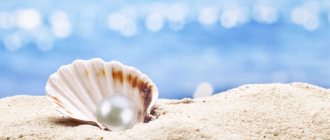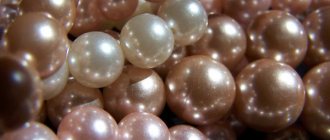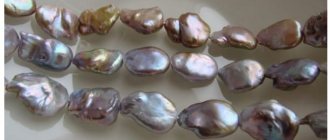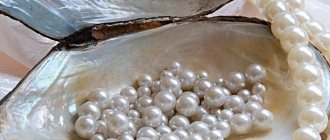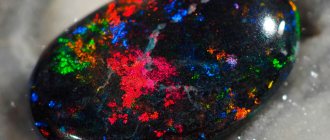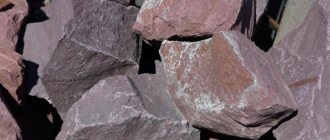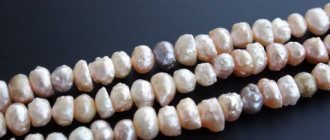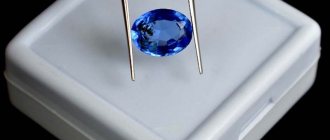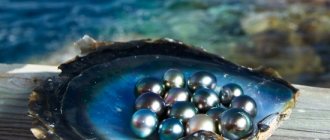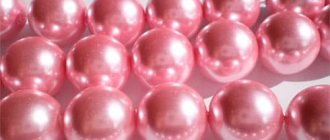| Stone type | Precious, semi-precious |
| Prevalence (Deposits) | Mexico, Panama, India, Tahiti, Sri Lanka, Japan, etc. |
| Varieties | Acoya, Baroque, Mabe, Mallorca, Oceanic, Freshwater, Tahiti, South Sea |
| Transparency | Translucent, opaque |
| Shine | Pearl |
| Mohs hardness scale | 3—4 |
| Chemical composition | CaCO3 |
| Color | White, blue, yellow, gold, pink, gray, black |
| Owner's color type | Spring, winter, autumn |
| Owner's temperament | Melancholic, Sanguine |
| Names | Andrey, Boris, Valentina, Galina, Eva, Evgeny, Evdokia, Inna, Irina, Claudia, Lilia, Margarita, Nadezhda, Oleg, Rosa, Sergey, Sofia, Elina, Yuliana |
| Zodiac sign | Libra, Cancer, Pisces |
| Date of Birth | from June 22 to July 22 from September 23 to October 23 from February 19 to March 20 |
| Chinese horoscope | Rabbit, horse, dog |
| Element | Water, Air |
| Planet | Neptune |
| Day of the week | Monday |
| Month | June, July, November, February |
| Season | Winter, summer, autumn |
| Numerology vibration | 2, 6, 7 |
| Chakra | Vishuddha, Sahasrara |
| What stones is it compatible with? | Aventurine, aquamarine, amethyst, turquoise, diamond, heliodor, heliotrope, garnet, emerald, moonstone, opal, rose quartz, ruby, chrysoprase, zircon, jasper |
| What stones is it not compatible with? | Beryl, malachite, sardonyx |
| Therapeutic effect (problems) | Blood pressure, vision, immunity, nervous disorders, memory and mental abilities |
| Therapeutic effect (on organs) | Organs of the gastrointestinal tract |
| Magic properties | Spiritual development, deception, strengthening relationships, black magic |
Natural pearls are classified as organogenic precious stones.
A mollusk is involved in the formation of the mineral. So, over the course of 10-12 years, a grain of sand that falls into a shell turns into a pearl. Stone is rare in nature, so man has learned to grow it on specially created farms. Growing cultured pearls solved two problems: to protect aquatic life from destruction and to satisfy the jewelry industry’s demand for the gem. Let's look at what cultured pearls are, how they are obtained and refined.
What it is
Cultured pearls are minerals created by man under special conditions. To understand what cultivated (grown) means, you need to know how a mineral is formed under natural conditions. To make a pearl, it is necessary that a grain of sand or other foreign object enters the cavity of the shell. It irritates the mantle, which begins to produce a special protein substance with a pearlescent sheen. The layer of mother-of-pearl gradually grows, and the pebble increases in size. The process of mineral formation takes 10-12 years.
The creation of special farms specializing in the production of natural pearls in artificially created conditions has made it possible to obtain selected minerals of various shades. The composition of the water and the type of shellfish are factors that determine the shade and intensity of the shine of the resulting stones. Both marine and freshwater mollusks are involved in the cultivation of minerals.
The process of pearl formation
Before learning about the varieties of this stone, let’s figure out how it appears in the wild. It is formed in the shells of mollusks . A foreign body gets inside the “house” of a marine inhabitant. It could be a grain of sand, an insect larva, etc. Thanks to its highly developed nervous system, the mollusk instantly reacts to outside interference. At this time, it secretes a pearlescent substance, which after a few years turns into that very rare bead.
Although many people think that the process of mining jewelry is simple and does not cause any problems, this is not at all true. In order to find it, people must open the shells, thereby harming the oysters . Moreover, not in every one of them you can find a treasure. Thus, mining of the mineral gradually leads to the disappearance of some species of mollusks. Therefore, at the moment, jewelry is mined in limited quantities in Japan, the Red Sea, and Sri Lanka. For this reason, the price of such a product cannot be low.
Wild pearls are almost never perfectly round
What colors does a natural gem come in?
- cream;
- white;
- black;
- silver;
- golden;
- pink;
- blue.
Due to the rarity of the wild stone, brilliance and wide range of colors, products made from natural pearls are of great value among jewelry products.
Growing methods
Pearl culture was invented in China. People involved in the cultivation of mother-of-pearl minerals collected live river mollusks and placed clay balls in their mantle. The shells were immersed back into the water, and a few months later they were caught and full-fledged pearls were removed from the cavity.
Be sure to check out: Features, properties and types of baroque pearls
Today, water farms are common in China, Japan, Venezuela, and the Philippines. There are 2 technologies for obtaining stone: nuclear and non-nuclear.
Nuclear
The essence of the method is to use only sea mollusks. First, full-fledged adult aquatic inhabitants are looked for. Experts evaluate the mollusk's mantle, as well as the functioning of the gonad, the reproductive gland.
What the growing process looks like:
- The shell is opened with special equipment.
- A small incision is made in the mantle.
- The seed core and the ball are placed in the incision.
- Closed shells are placed in water.
Interesting! Over the course of a year, the thickness of the mother-of-pearl layer increases by 1 cm. Several years are enough to form a full-fledged stone.
Which pearls are better: sea or river pearls?
There is no clear answer to the question of which pearls are better. Each type has certain advantages. Marine has larger sizes and higher cost. It is often counterfeited, passing off plastic beads and ennobled stones as the original.
Freshwater pearls are cultivated on a large scale. It is actively grown in shellfish in former rice fields in China. The selection of the introduced seed nucleus allows one to obtain a variety of sizes and shapes. This increases the demand for freshwater gemstones.
When growing freshwater pearls, farmers monitor water levels. They turn the oysters in a timely manner so that the stones do not turn out one-sided. A person influences all external growth parameters, but does not artificially increase nacre. All processes occur naturally inside the mollusk. Maintaining optimal conditions allows you to achieve the correct shape of pearls. This is the main advantage of river gems.
Nuclear-free
This is a simpler cultivation technology. Both river and freshwater mollusks are used in the process of growing stone. An ordinary grain of sand is used as the basis for the future gem. Pearls take several years to mature. This method is suitable for obtaining small gems, the diameter of which does not exceed 8 mm.
Natural pearls and cultured ones... What is the difference and is there any at all??♂ Thank you very much for the ❤, we are very...
Published by Diamant Thursday, August 1, 2022
Formation in shell
Natural pearls in nature are produced by certain species of river and pearl species of marine mollusks. Only specimens covered with a natural layer of mother-of-pearl have commercial value. Only the following mollusks can have a shell with a pearl:
- double-leaf type;
- individual gastropods;
- one type of cephalopod;
in freshwater representatives of the unionidae family, these include toothless combs, barley combs, and folded combs.
Which shells produce pearls?
Bivalves of the sea are the main source, they include:
- oysters;
- mussels;
- sea scallops.
Shells with shapeless pearls, which are called “baroque”, are mainly formed by river inhabitants.
Pearls in mollusks in the form of a pear, irregular oval, spherical shape, blister (button) are found mainly in seashells.
The shape depends on the location in the shell and is sometimes very bizarre, such as “monsters” or “paragons” - formations in the form of animals or humans.
What affects external characteristics
The condition of the resulting pearls depends on the growing conditions. If freshwater stone is cultivated, the shells are placed on the bottom of lakes and rivers. Freshwater pearls take longer to mature. So, in the first 2 years, the thickness of the built-up mother-of-pearl layer is 2-3 mm. To obtain a mineral with a diameter of 8-9 mm, you need to wait 6 years. The chemical composition of water affects the shade of the gem. In fresh water you can get peach, white, purple and pink pearls. River stone rarely takes the shape of a ball. Freshwater cultured pearls are often teardrop-shaped and oval.
Growing pearls on farms located in the open sea produces large, perfectly round minerals. It is possible to cultivate large gems within 5-7 years. Under the influence of the chemical composition of sea water, a uniform shiny layer of mother-of-pearl is formed on each gem. However, the process of cultivating miners can be hampered by a sea storm and a sharp cold snap.
What is a pearl and its contents
The composition of pearl is similar to that of nacre from a mollusk shell. In addition to the predominant calcium carbonate, it includes:
- Conchiolin is an organic keratinized protein substance that forms the base (framework), pearls, and outer layer of the shell.
- A more accurate analysis shows the presence of magnesium, manganese, titanium, strontium, zirconium, silver - elements inherent in Crimean pearls.
Number of pearls in one shell
In the shells of Black Sea mussels, the number of pearls can range from several dozen to more than a hundred pieces. As the number of pearls increases, their size decreases - 2.5-3 mm, which reduces the value of the product.
Refinement of cultured pearls
Masters practice several methods of refining minerals grown on pearl farms:
- Secret technology for enhancing shine: pearls are soaked in a special composition, including a complex of mineral salts and methyl alcohol. The shine is pronounced, but this effect lasts up to 6-12 months. Then the mineral takes on its original appearance, which is the disadvantage of the technology.
- Dyeing: This beautification technique is applied to the popular Akoya variety. This type of pearl is white, and dyeing with special compounds allows you to achieve a pinkish tint.
- Radiation exposure: When exposed to radiation, pearls with a large amount of manganese in their composition change color.
- Filling cracks and pores: Most pearls have irregularities (chips, pores, cracks). To correct defects, epoxy resins and polymer compounds are used.
The more you have to work on refining the pearls, the cheaper such a stone will cost.
Would you buy jewelry with cultured pearls?
Not really
What is the difference between natural pearls and artificial pearls?
- Inspect the surface carefully. Real pearls will always have some deviations or imperfections. If it looks too good, it's most likely an imitation.
- Inspect the drilled holes. The fake here usually shows unusual wear or flaking. Often a plastic bead is exposed.
- Real pearls are made by nature, so their size should vary slightly.
- High quality pearls will have a deep shine, as if glowing from within.
- A natural pearl usually weighs more than a fake one.
- Inspect the drilled hole. Counterfeits often have traces of melted plastic around the edges.
- Feel the pearls. Is it cool to the touch? The real thing does not heat up to the touch as quickly as the artificial one.
- A real pearl necklace will have depth and color variation. This will include body color and overtone color. Often displaying different colors under different lighting conditions.
- The surface will be rough. Gently rub the two pearls into the strands. If they are a little gritty and you feel some resistance, then they are most likely real.
- What type of clasp is used? Silver or gold are most often used with natural pearls.
- Real pearls in beads are often linked together.
You will also be interested to learn about the different forms of pearls and the reasons for their formation.
I wish you good luck in choosing jewelry!
Assessment methods
The quality of pearls is assessed according to the following criteria:
- weight;
- shine;
- color;
- form;
- size;
- characteristics of the mother-of-pearl layer;
- surface.
Be sure to see: Properties and power of the mysterious jet
NATURAL AND CULTURED PEARLSNatural (not cultured) pearls These are any type of pearls formed...
Published by Maysaku Monday, April 7, 2014
The unit for estimating the mass of a stone is considered to be a pearl grain. 1 grain = 50 mg or 0.25 carats. The greater the mass, the higher the value.
Interesting! The intensity of the mineral's shine depends on the number of layers of mother-of-pearl and their thickness. If the stone has many layers, then its shine will be pronounced. The X-ray method is used to assess the thickness of nacre. The diameter of the stones is another important evaluation criterion. The sizes of freshwater minerals start from 3 mm, sea minerals – from 5 mm. The sphere is the standard form of the gem. The more the shape of the stone differs from the ideal, the lower its value.
Pearls are found in jewelry in a variety of shades, from snow-white to black. Jewelry that has received a beautiful shade without refining is highly valued.
Despite the fact that it is not possible to grow pearls with an ideal surface, stones with a minimum of defects are highly valued in jewelry.
Checking the barcode of pearls
ATTENTION! The correct barcode is not a 100% guarantee of the originality of the pearl. At the same time, an incorrect barcode is a clear sign of counterfeit.
To check the authenticity of pearls, enter the numbers in the field and click the “Check” button. If the barcode is correct, then it is recommended to also check the country of origin.
Important! This service checks the relevance and correctness of the applied barcode, but does not guarantee that the entered code is not taken from another product and the jewelry being checked is not counterfeit.
Magical and healing qualities
Pearl is a female talisman. In ancient times, pearls personified spiritual purity, innocence and devoted love. Jewelry with sea gems was given as a sign of recognition of sincere feelings. There was also an opinion that pearls symbolize tears, and therefore attract sadness and loneliness into a woman’s life.
Today the pearl is regarded as a talisman of family happiness. For married women, jewelry helps maintain mutual understanding and devotion in the family. The gem favors lonely girls in search of a soul mate.
Pearl is a mineral that will help a person establish relationships with others and become pleasant in communication. Attracts an aura of friendship and mutual support. Pearls favor people who dream of developing entrepreneurial talent.
From the point of view of zodiac compatibility, the energy of the gem is suitable for representatives of the element of Water. It is better for fire signs to refrain from wearing jewelry with pearls.
The stone is endowed with powerful healing energy, so it helps a person get rid of numerous ailments. Pearls heal both soul and body. Talismans with the mineral are suitable for people suffering from kidney and liver diseases. The energy of the stone perfectly calms the nervous system, helping to get rid of phobias and obsessions.
There is a belief that pearls can warn their owner about health problems. If jewelry becomes dull and loses its luster for no apparent reason, this indicates the initial stages of cancer processes in the human body.
Types of pearls by color
Pearls boast a rich natural palette of shades. It can be white, yellowish, black pink, blue, cream, green, silver or any other. The further the shade is from white and the brighter the color of the bead, the more attractive and expensive it is.
Varieties of color
Shine
The shade of the gemstone depends on the characteristics of the mollusk’s organism. Therefore, not only light beads are found in nature, but also exotic black ones. They are actively harvested in Tahiti from oysters of the species Pinctada margaritifera. This is the only black pearl that is completely natural. The remaining black beads are either dyed or obtained by x-ray irradiation.
Black beads
Imitation black sea pearls are made from cheap river pearls. It is refined by exposure to radioactive radiation. The stone takes on a dark gray color with a metallic tint, unnatural for nature.
Mostly freshwater pearls are suitable for radiation enhancement. If you irradiate the sea, the impact will go to the core. It will darken and become visible through the outer layer of mother-of-pearl.
Original pearls often have an uneven color. There are spots with more or less shine on the surface. The coloring of fakes is always the same.
Dark pearls are also obtained by treating them with silver nitrate. Sea stone takes on a silvery tint, while river stone takes on a grayish tint. It also has a metallic artificial shine.
What is the difference between artificial and cultured pearls
Cultured stone is mistakenly called artificial. The reason for the confusion is that artificial conditions are created for the cultivation of pearls. In fact, cultured pearls are natural, since the process of their formation is impossible without the mollusk and its usual habitat. This is the key difference between grown stone and imitation stone.
The synthetic gem is produced in an industrial environment. The essence of producing a copy of the mineral is to use pearl essences, including gelatin mass. It is then painted with a mother-of-pearl composition and poured into special spherical shapes. After the mass hardens, the resulting balls are hollow, much like real pearls.
Interesting! There is another way to make imitations, which is to use a glass base for stones. The glass is formed into balls, onto which a thick layer of pearl essence is then applied. Strength is ensured by the use of compounds enriched with formaldehyde, alum, and mineral salts. The cheapest replicas of pearls are made from plastic mass. Pearlescent paint is applied to the finished balls.
Which pearls are considered the most valuable?
The most valuable are natural sea pearls. It is large in size, since the biochemical composition of salt water contributes to the intensive production of mother-of-pearl. Freshwater pearls are also valuable, but are much more common. The reason for this lies in the fact that freshwater mollusks contain up to several dozen stones.
Cultured pearls are less valuable. It is not considered a fake if information about its origin is not hidden. Under human supervision, up to 20 pearls are grown inside each oyster. 98% of the stones sold are the cultivated variety.
Treated pearls are even less valuable. It goes on sale after special processing, often using x-rays. Treated stones are sometimes passed off as black pearls.
Imitation pearls using glass or plastic have the least value. Such beads are widely used in jewelry. Most fakes are made from cheap materials coated with low-grade paint.
The value of a pearl is influenced by its color, luster and surface uniformity. The size of the gemstone also matters. It is desirable that the pearls have the correct shape.
Parameters influencing value
How to spot a fake
In most cases, an artificial mineral is sold at the price of a real one, which is a deception for the jewelry buyer.
How to distinguish a genuine gem from an artificial one:
- The surface of natural stone cannot be perfectly smooth. A small number of dents are acceptable.
- Beads made from a genuine gem cannot consist of ideally shaped pearls.
- If you throw a natural bead on a hard surface, the product will spring back slightly, since natural pearls are characterized by a layered structure. A fake does not have such properties.
- If you rub a natural stone on a thick fabric, the shade will not change.
- The natural gem almost does not heat up from the warmth of human hands, remaining cool.
To be sure of the authenticity of the jewelry you are purchasing, choose it from jewelry boutiques with an excellent reputation.
How to care for products made from non-natural pearls
Many people are interested in the question of how to clean products made from non-natural minerals at home so that they remain beautiful and shiny for as long as possible. Caring for beads, necklaces, bracelets, and rings with imitation minerals requires following some recommendations:
- Products should be thoroughly wiped with a soft cloth or napkins.
- Do not immerse jewelry in water or solutions containing chemicals; to clean heavy stains, it is better to use a damp cloth.
- You cannot swim in the products, take a shower or bath, or visit a swimming pool, bathhouse or sauna.
- Non-natural beads cannot be treated with steam or ultrasound.
- It is worth remembering that fake pearls, just like natural ones, do not tolerate the effects of styling varnishes, perfumes, deodorants and various creams.
- It is not recommended to allow jewelry to come into contact with alcohol, vinegar, chlorine and other aggressive substances.
- Products made from unnatural Burmitz grain prefer to be stored in special bags for jewelry or in a box with soft, preferably velvet, upholstery.
Main conclusions
- Pearl cultivation makes it possible to satisfy the jewelry industry's need for selected stones of natural origin. If the mineral were mined in natural conditions, a huge number of living mollusks would have to be destroyed.
- The gem is grown on special farms created in fresh water bodies and seas. River (lake) pearls differ in appearance from sea pearls, since the characteristics of the mineral are influenced by the chemical composition of the water and natural conditions.
- Refining a stone allows you to hide defects, without which no natural gem can be imagined.
- When assessing the quality of pearls, the shape, shade, luster, and thickness of the nacre are determined.
- Cultured and cultured pearls are not the same thing. Synthetic stone is manufactured in industrial conditions. Both types of mineral have different physical properties, so cultured pearls are easy to distinguish from artificial ones.
Advantages and disadvantages of cultivation
A significant advantage of cultivation is the guarantee of careful handling of shellfish. When extracting natural materials, the pearl oyster is often damaged, leaving no chance for the shell to continue its life. On farms, one shell is used to form 4-5 stones, after which it is returned to its usual habitat.
The high strength of minerals is also considered an advantage. Artificial pearls are much stronger than natural ones and can withstand external influences. Again, cost is an added benefit, as cultured pearls will be cheaper than mined natural minerals.
There are almost no disadvantages to cultured pearls, with the exception of the low strength of river pearls.
Cultivating pearls is an exciting and profitable business that is successfully carried out by farmers in various regions. This process allows the pearls to be carefully grown in the most suitable conditions. There are many types of priceless pearls; a photo cannot always convey the splendor and beauty of the minerals.
Coating quality
We will check the abrasion of the coating using friction against a fairly abrasive surface (in ordinary life, beads do not experience such impacts, so we will consider further tests to be destructive).
To begin with, I sewed beads onto the base, took a piece of a hard door mat and rubbed it conscientiously for 20-30 minutes while watching some live broadcast.
Most of the beads withstood this impact, the glossy ones were a little scratched, and the matte ones were also stained on the brown rug, but overall they all looked very good!
And now instead of a rug - fine sandpaper!
Work until the paint is completely erased to assess the thickness of the pearlescent coating.
The matte beads suffered more damage again. Perhaps the glossy finish is harder.
Proper care
Cultured pearls are sensitive to physical influences, as they have low hardness values (no more than 4 on the Mohs scale). Therefore, you need to store it in a separate box. Wrapping it in cloth will reduce the chance of damage to the surface. You should also consider the following care features:
- Contact with chemicals and cosmetics is prohibited;
- Avoid exposure to bright sun, strong wind and water;
- tobacco smoke has a negative effect on shine;
- during storage, it is important to maintain the level of humidity, since excessive dryness leads to the formation of cracks;
- dust must be cleaned periodically with a soft, dry cloth.
If sweat or dirt gets in, wash with mild soap and water. Do not leave wet items to dry naturally. Freshwater pearls are believed to be more durable and easier to care for.
If you do not clean the pearls from dust, their surface will be damaged and it will be impossible to repair. In this case, roughness appears and shine is lost. With more severe damage, microcracks may appear and the strength of the stone may decrease.
Types of pearls by shape
The shape of natural pearls is most often slightly irregular. Beads are ovoid, pear-shaped, elongated or elliptical. Perfectly round real gems are rare. They are mainly used in rings and earrings. Most round pearls are obtained through cultured methods.
Variety of shapes
Description of types of forms
Hemispherical pearls are often found. It is cultivated mainly in Japan, the USA and China. Such a stone grows directly on the shell itself, and not inside it. This affects the shape of the gem.
Hemispheres are the most common and best-selling. They are cheaper than other types of pearls. Hemispherical gems are used in the manufacture of bracelets, pendants, rings and earrings.
Hemispherical shape
The largest pearls are grown in mollusks that live in the southern seas of Australia, Indonesia and the Philippines. The diameter of the gems reaches 20 mm. The large size is the reason for the high cost of natural stones from the South Seas.
Pearls with attractive shapes are called baroque. If the shapes of the gemstone are similar to the silhouettes of animals or any objects, then these are paragons. Gems of this type often become natural talismans. They are often framed in gold.
Types of forms
